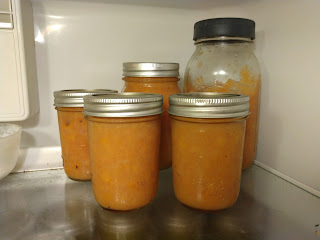 |
| This year's applesauce |
I live near the coast of Maine where the growing season is relatively short. Nonetheless I manage to harvest quite a bit of food from my property. For me, living sustainably entails optimizing use of my land and natural resources. And I like the idea of having my own homegrown and affordable food sources.
It is mid September as I write this and I have recently canned several jars of applesauce. The apples on my tree are small and very sweet and I often pick one just to eat during the day, and I give away or sell my applesauce to friends and neighbors.I started harvesting my cucumbers a month or so ago, for me cucumbers in a salad are the essence of summer! I plant them from seed in the early spring. They are very easy to grow - all I do is keep them watered.
The first edible plant that shows up in my vegetable beds in the spring are my chives. Pictured here are regular chives and garlic chives. I use these freshly cut in scrambled eggs and stir fries a lot. The garlic chives have a real garlic "zing" that imparts a lot of flavor to stir fries.
At the end of the season I chop them up with scissors and put them in the oven on parchment paper for half an hour so at about 150°F. I can then store them in a canning jar and use them throughout the winter and spring.
 | |
| blueberries on the left and canned pesto on the right |
In November I plant garlic cloves and bed them in with mulch or wood shavings from my wood turning classes. When I see shoots coming up in the spring I rake off the mulch and water them throughout the season, harvesting them in August. I try to balance the number of basil plants with garlic so I have the right amount to prepare pesto with some left over for other cooking.
Throughout the year, I like to grow broccoli sprouts in a mason jar in my kitchen using a special drainage lid that I purchased for this purpose. It takes the sprouts about a week to grow and then it's relatively simple to strain out the seeds that didn't sprout and they will keep in the fridge for a week or so. Broccoli sprouts have a pleasant tang reminiscent of radish and are filled with valuable nutrients. I use the sprouts on my sandwiches and in salads.
Pictured at right are my four blueberry bushes that are over 23 years old now. Every spring I go through them and meticulously prune them to optimize production. I typically can at least 30 jars of jam and sell it to friends and visitors. This year's production yielded over 40 jars! Apparently I have a reputation of making very good blueberry jam.
Every year I carefully review a video from the University of Maine to remind myself of all the details of how to properly prune and maintain my blueberry bushes. You would be surprised how brutal you have to be when pruning these bushes.
I make my blueberry jam in small batches of five using just a saucepan. I sterilize the jars and lids in another saucepan and frying pan.
At left you can see one of my vegetable beds in the spring where I co-planted nasturtiums with basil seedlings. Nasturtiums flowers and leaves are both edible and add a little zing to a salad and the flowers add a decorative touch. The nasturtiums also provide a good bee habitat.
Speaking of bee habitat, pictured at right is the first flowering tree on my property to bloom in the spring which is a dogwood. This is followed by my other fruit trees including crabapple, plum, apple and cherry. I also have a beautiful decorative crabapple tree next to the house that the bees really enjoy. Birds also enjoy those crab apples which are about the size of a pea.
I recently took an adult Ed evening class on how to process acorns into edible food. I have a couple of red oak trees in my front yard that dropped a lot of acorns and there aren't enough squirrels or chipmunks to eat them all so this year I'm planning to experiment with processing them as edible nuts. Once they are shelled and the nuts have been boiled sufficiently to remove the tannins, I'm hoping to then add some flavor by roasting them with sugar so that they are similar to honey roasted peanuts. We'll see how that goes…


.jpg)












No comments :
Post a Comment
I welcome all thoughtful comments and feedback!